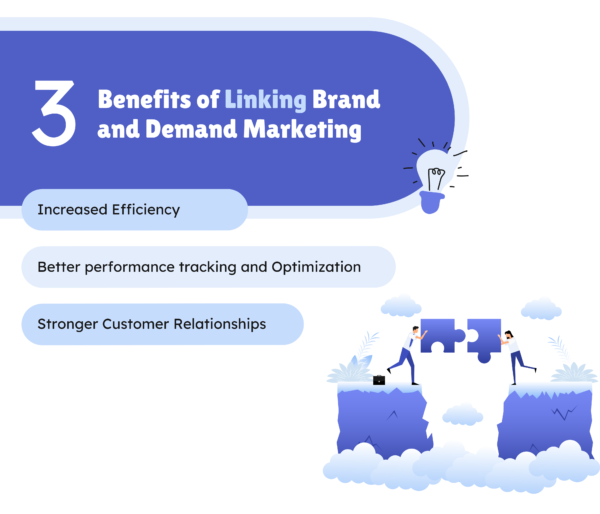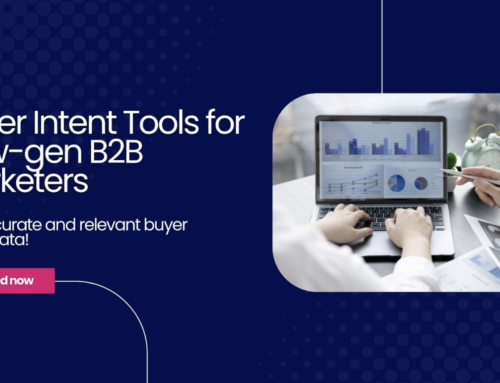In a fast moving digital landscape dominated with the increase in technology, doing marketing right becomes pivotal and two key strategies take the spotlight: Brand and Demand marketing.

Intro
Be it a B2C or B2B brand, the current macroeconomic conditions makes it challenging to create strategic choices when it comes to budget and investment between branding and demand marketing. But moving forward to thrive in the market requires the right strategy.
“So then, what is the right mix of investment across brand and demand?”
While the purpose of both approaches walk in two different paths, bridging the gap between the two turns out to be important for a holistic successful marketing strategy.
Brand marketing is like the trust builder where attention is driven on building trust and raising reputation which as a result strengthens long term customer relationships. On the flip side, demand marketing is more like the sales engine that drives immediate sales and generates leads.
An article from SiriusDecisions indicates that 90% of C-suite buyers say the brand is moderately to significantly influential in shortlisting the buying process.
Here’s an in-depth look at the two approaches,
Brand marketing
All about how you encourage customers to choose your brand over competitors- again and again.
Brand marketing is the art of crafting and nurturing a company’s image over the long term. The aim here is to create a positive perception in the minds of the audience, one that resonates with their needs, values, and desires. Effective brand marketing leaves a lasting impression built on a foundation of trust and emotional connections.
This strategic approach supports the company’s overall marketing efforts by:
- Establishing a strong, recognizable identity
- Differentiating the brand in a competitive marketplace
- Creating a consistent message across all touchpoints
Psychology plays a vital role when it comes to marketing, and big brands like Apple and Coca Cola sell emotions on the first hand before the product.
B2C companies like Disney and Amazon sell memories and convenience before playgrounds and products. B2B companies like Hubspot and AirBnb developed strategies to get close to the lives people’s lives through lifestyle. Think about the interesting content and goofy bear made by HubSpot to stand out.
This defines the power of brand marketing: It transcends the product, embedding itself into the customer’s daily lifestyle which leads into supporting their decision making process.
“Branding is like an invisible thread at the bottom line that connects a customer emotionally towards the brand.”
Demand marketing
All about capturing the audience’s attention and encouraging immediate interaction.
Tactical, data-driven, and often short-term focused, where the goal lies in converting interest into action—whether it’s a purchase, a sign-up, or another form of engagement. Tactics include targeted ads, email campaigns, SEO, and promotions.
Demand marketing is crucial for keeping the sales funnel full. Without it, even the most recognizable brands could struggle to maintain steady revenue streams. Thereby, this ensures that your brand’s message reaches the right people at the right time, prompting them to take action.
Bridging the Gap: Why Integration Matters?
Brand marketing creates the fertile ground so that demand marketing efforts can be effective and thrive in the marketplace. A user is more likely to click on an ad if they already have a positive connection built with the brand and in the same way demand marketing can amplify brand marketing efforts by driving traffic and engagement, which reinforces the brand’s presence in the market.
Yesterday, these two functions were treated as separate entities, but today as customer journeys have become more complex and nonlinear, the separation of these functions has become less effective. Consumers interact with brands across multiple touch points, and their perceptions and behaviors are influenced by both brand messaging and demand-driven content.
3 key obstacles and how to overcome
Resonating with the target audience
Resonating with your target audience is the foundation of any successful brand strategy. To achieve this purpose, understanding who your customers are in terms of what they value and what motivates their purchasing decisions are two essential key identifiers on the list. Detailing the customer persona as much as possible will result in a clearer view on who the ideal target audience is from a crowded market place. Once, the step is done – craft a brand message that speaks loud to the different aspects of the target group. The key is – how deep can this emotional connection dive? The more intensity the more likely to create a solid ground of loyalty.
Staying up to date with trends
Adapting to new trends emerging at a rapid pace is like a turtle trying to keep up with a rabbit in a race. This is an essential strategy for maintaining relevance and ensuring that the brand remains competitive in the market. Consider maintaining updates on industry developments, consumer behavior shifts and technological advancements. Adapt marketing strategies accordingly to capitalize on new opportunities or mitigate potential risks. The shift might sometimes involve embracing new platforms, adapting innovative content formats or even re-creating your message to align with your current customer sentiments. The key lies in the speed in which you can adapt to these changes.
Aligning demand marketing with business goals
The alignment ensures that all marketing efforts are not centered on generating leads but also contributing to broader business objectives such as – increasing revenue, improving customer retention or expanding market share. This might involve integrating your demand generation efforts with your sales processes, using data analytics to track and measure the impact of campaigns and continuously optimizing your approach based on performance metrics. The key here is to give focus to the entire customer journey from awareness to consideration to conversion – to ensure that every stage of the marketing strategy is working in harmony to achieve your business goals.
5 Practical Strategies you should consider when bridging the two approaches
Unified Messaging
A brand voice remains as a powerful asset of a company. Unified messaging is the idea and strategy done behind marketing efforts to ensure that the brand voice remains consistent, whether brand focused or demand driven. When a user encounters a brand video or a direct-response ad, they need to experience the same tone, style, and core message.
This consistency plays a crucial role in building a cohesive brand identity that resonates with your audience at every touchpoint. As a result, this strengthens the brand reinforcing the brand’s value proposition, making every interaction with the audience only a step closer to deepening the bond with the brand.
Cross-Functional Teams
Foster collaboration between your brand and demand marketing teams. Shared goals and regular communication can help align strategies, ensuring that both teams are working towards a common objective.
Foster effective collaboration between brand and demand marketing teams so that it enables both teams to nurture content, share insights, address challenges and align goals on the same page. Start by defining clear, measurable objectives that both teams work towards, ensuring alignment and breaking down silos.
This supports keeping strategies aligned with evolving market dynamics and business priorities.
Customer Journey Mapping
Understanding and mapping out your customer’s journey by identifying the key touch points from brand awareness to conversion gives a better chance for creating a way for your brand to interact with potential customers. This builds the opportunities to integrate consistent brand messaging into your demand campaigns. When customers encounter a unified message across various channels, it builds trust and reinforces brand recognition, ultimately driving towards conversion.
Data-Driven Insights
Analyzing customer behavior, preferences, and interactions, can lead to gaining valuable insights into what and what does not resonate with your audience. This approach enables you to adjust your brand-building activities to better support demand generation, ensuring that each effort complements the other. If data reveals that certain brand messages lead to higher conversion rates, more prominence can be given to those messages in the demand campaigns. This alignment does not only maximize the impact of marketing efforts but also ensures that strategies are continually optimized for better results.
Content Strategy Alignment
Developing a content strategy that serves both brand awareness and demand generation requires a thoughtful approach. For example, a blog post that tells a compelling story about the brand’s mission can simultaneously include a call-to-action that encourages readers to explore the company’s products or services. This blend of storytelling directly offers the audience to be engaged while subtly guiding them through the sales funnel. In return, this not only enhances brand perception but also contributes to the bottom line.
When these two forces come into contact, the result is a principled cycle of growth, loyalty, and success that can propel the business into stepping to new milestones.
The Benefits of Integration
Increased Efficiency
By merging the strategic aspects of brand marketing with the tactical execution of demand generation, companies can streamline their marketing efforts. Resources are utilised more effectively, reducing redundancies and maximising return on investment (ROI).
Stronger Customer Relationships
While brand marketing nurtures long-term relationships, demand generation provides immediate value, creating a balanced dynamic that enhances customer loyalty.
Better performance tracking and Optimisation
With an integrated approach, it becomes easier to measure the impact of marketing efforts across both brand and demand objectives. Marketers can track how brand awareness campaigns influence demand metrics and vice versa, leading to more informed decisions and better optimization.

Conclusion
In an era where cutting through the noise is increasingly challenging the “brand to demand” approach serves as a unifying approach that with the right direction will positively impact both customer experience and brand objectives. By investing the right time and efforts for your brand development, maintaining consistency, scaling personalisation, and staying relevant, you create a robust platform for growth.
It is not just about your brand being a part of merely a conversation – but what makes the conversation going.





